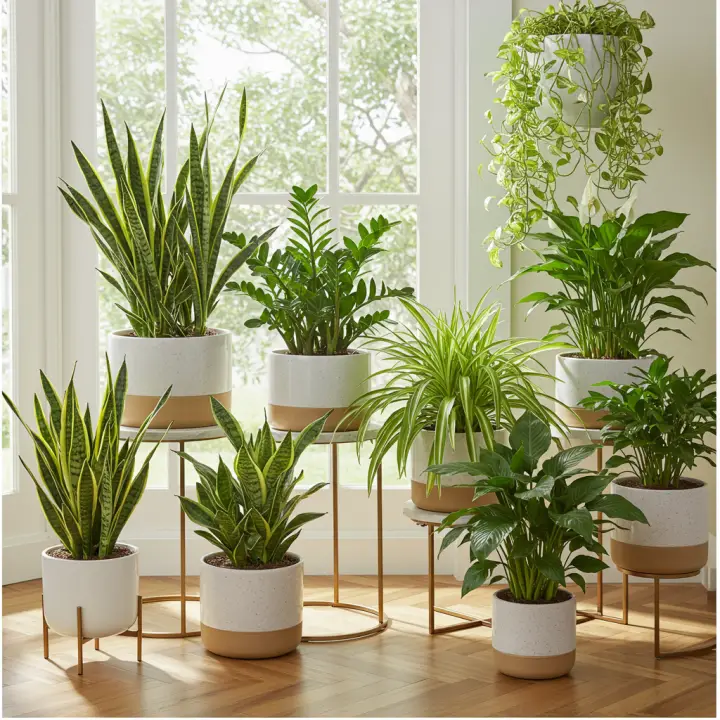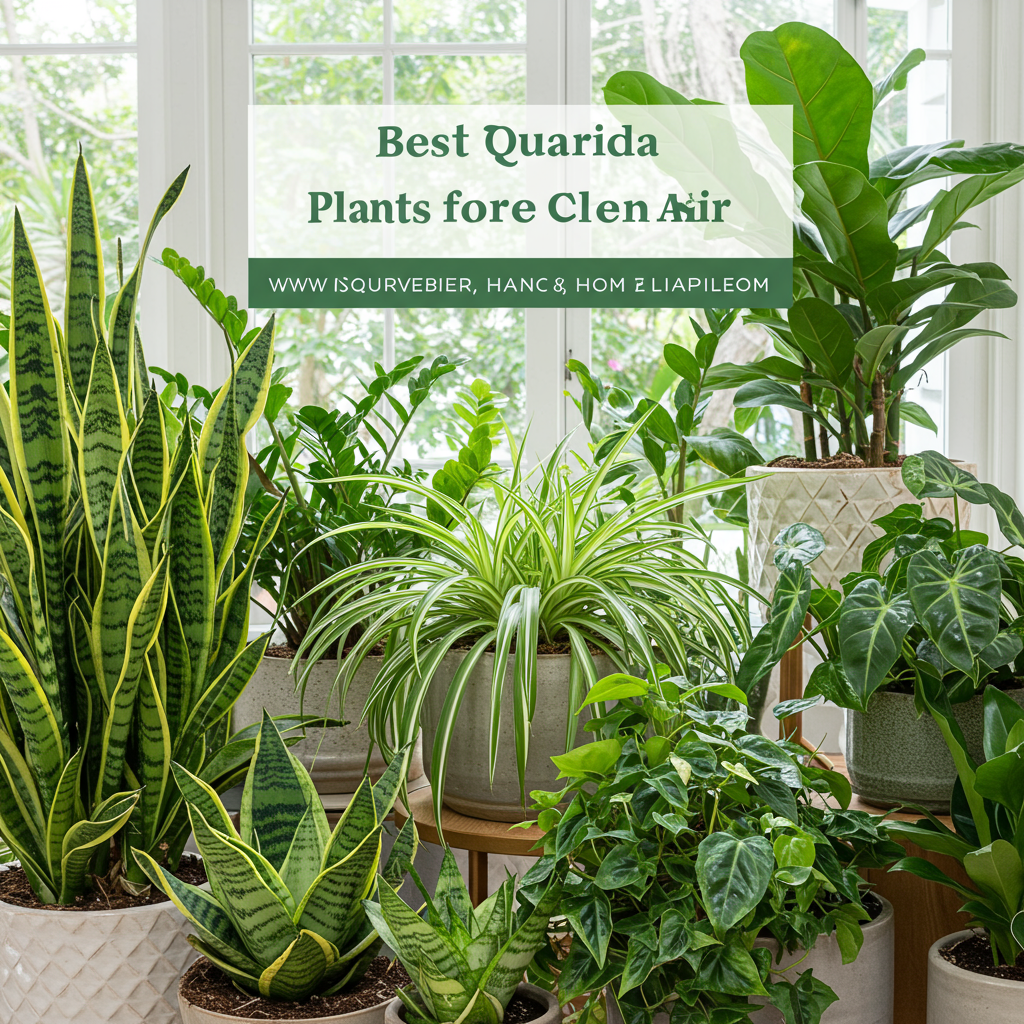Discover Florida’s air-purifying indoor plants that not only thrive in the Sunshine State’s unique climate but also actively cleanse your home’s air. Learn about the top picks and how to care for them to enjoy a healthier indoor environment.

A Breath of Fresh Air: Why Indoor Plants Matter in Florida
In our modern world, the air inside our homes can often be more polluted than the air outside. Volatile Organic Compounds (VOCs) released from furniture, cleaning products, paints, and more can accumulate, impacting our health and well-being. For Florida residents, this challenge is amplified. Tight, air-conditioned homes designed to keep the heat and humidity out can also trap these airborne toxins.
Fortunately, nature offers a beautiful and effective solution: indoor plants. Beyond their aesthetic appeal, certain plants are remarkable natural air purifiers, working tirelessly to filter out harmful substances. This post will guide you through the best air-purifying indoor plants that not only survive but truly thrive in Florida’s unique climate, helping you create a healthier, greener living space.
The Science Behind Air-Purifying Plants
The concept of plants cleaning our air gained prominence from a groundbreaking NASA study in the 1980s. This research revealed how common houseplants can effectively remove toxins like formaldehyde, benzene, and trichloroethylene from the air.
How Plants Clean Your Air
Plants clean the air through a dual process:
1. Photosynthesis: While plants absorb carbon dioxide and release oxygen, their leaves also absorb harmful gases, breaking them down into less toxic compounds.
2. Soil Microbes: The microscopic organisms in the plant’s potting soil play a crucial role, converting airborne toxins into nutrients for the plant.
Why Florida Homes Benefit
Florida’s climate presents unique indoor air quality challenges:
Sealed Environments: Homes are often tightly sealed to maximize air conditioning efficiency, which can trap pollutants indoors.
High Humidity: While Florida offers natural humidity, this can sometimes contribute to mold or mildew growth if not managed, though plants can help regulate humidity levels.
Construction Materials: New homes or renovations can off-gas VOCs for extended periods.
Introducing air-purifying plants can significantly mitigate these issues, offering a natural and beautiful way to improve your indoor air quality in the Sunshine State.
Top Air-Purifying Indoor Plants Perfect for Florida Homes
Selecting the right plants for Florida means choosing varieties that appreciate warmth, humidity, and can tolerate typical indoor lighting. Here are some of the best air-purifying indoor plants that flourish in the Sunshine State:
1. Snake Plant (Sansevieria trifasciata)
Why it’s great for Florida: Extremely drought-tolerant and adaptable to various light conditions, from low to bright. It’s almost impossible to kill, making it perfect for busy Floridians.
Air-Purifying Power: Excellent at removing formaldehyde, benzene, trichloroethylene, and xylene from the air, even at night!
2. ZZ Plant (Zamioculcas zamiifolia)
Why it’s great for Florida: Another incredibly resilient plant that thrives on neglect. It tolerates low light and infrequent watering, ideal for forgetful plant parents.
Air-Purifying Power: Known to effectively remove xylene, toluene, and benzene.
3. Areca Palm (Dypsis lutescens)
Why it’s great for Florida: A tropical beauty that loves warmth and humidity, making it feel right at home in a Florida house. It also acts as a natural humidifier.
Air-Purifying Power: A top performer for removing formaldehyde, xylene, and toluene.
4. Peace Lily (Spathiphyllum)
Why it’s great for Florida: Elegant, with beautiful white blooms and a preference for humid conditions. It signals its thirst with drooping leaves, making watering easy.
Air-Purifying Power: Battles ammonia, benzene, formaldehyde, and trichloroethylene.
5. Boston Fern (Nephrolepis exaltata ‘Bostoniensis’)
Why it’s great for Florida: This plant thrives in high humidity, which Florida often provides. It’s a classic choice for hanging baskets.
Air-Purifying Power: An excellent humidifier and very effective at removing formaldehyde and xylene.
6. Spider Plant (Chlorophytum comosum)
Why it’s great for Florida: Super easy to grow and propagate, producing “spiderettes” that can be shared. Tolerates a range of conditions.
Air-Purifying Power: Known for removing formaldehyde, xylene, and even carbon monoxide. Great for beginners!
7. Pothos (Epipremnum aureum)
Why it’s great for Florida: A trailing plant that’s incredibly versatile, growing well in hanging baskets or on shelves. It’s very forgiving and can handle some neglect.
Air-Purifying Power: Removes formaldehyde, carbon monoxide, benzene, xylene, and toluene.
8. Dracaena (Dracaena species)
Why it’s great for Florida: Available in many varieties (e.g., ‘Dragon Tree,’ ‘Corn Plant’), offering diverse looks. They generally prefer consistent, moderate light and humidity.
Air-Purifying Power: Effective against benzene, formaldehyde, trichloroethylene, and xylene.
Care Tips for Thriving Clean Air Plants in Florida
To ensure your air-purifying plants are working their magic, proper care is essential. Florida’s climate offers some advantages, but specific attention will help them flourish.
Light Requirements
Match the Plant to the Spot: Research each plant’s specific light needs. While many tropical plants enjoy bright, indirect light, some, like Snake Plants and ZZ Plants, can tolerate lower light conditions. Avoid direct, harsh Florida sun that can scorch leaves.
Watering Wisdom
Don’t Overwater: This is the most common killer of houseplants. Always check the soil moisture before watering. Stick your finger an inch or two into the soil; if it feels dry, it’s time to water.
Drainage is Key: Ensure all pots have drainage holes to prevent root rot.
Humidity Loves
Embrace Florida’s Humidity: Many of these tropical plants love the high ambient humidity of Florida.
Misting & Pebbles: If your home’s AC keeps the air very dry, occasionally misting leaves or placing pots on a pebble tray with water can boost humidity.
Soil and Fertilization
Well-Draining Soil: Use a good quality potting mix that drains well. Many plants prefer a slightly acidic to neutral pH.
Occasional Feed: Fertilize sparingly during the active growing season (spring and summer) with a balanced liquid fertilizer, following product instructions.
Pest Control
Inspect Regularly: Check your plants for common pests like spider mites, mealybugs, and aphids.
Organic Solutions: Use neem oil or insecticidal soap for treatment, if necessary. Healthy plants are more resistant to pests.
Beyond Greenery: Additional Benefits of Indoor Plants
The advantages of inviting green companions into your Florida home extend far beyond air purification:
Stress Reduction: Studies show that interacting with nature, even indoors, can lower stress levels and blood pressure.
Improved Mood: The presence of plants can boost feelings of well-being and happiness.
Increased Productivity: For those working from home, plants can enhance focus and creativity.
Enhanced Aesthetics: Plants add natural beauty, color, and life to any room, turning your house into a home.
* Sound Absorption: Larger plants can even help to absorb sound, making rooms feel calmer.
Frequently Asked Questions (FAQs)
Q1: Do all indoor plants clean the air?
A: While all plants convert carbon dioxide to oxygen, not all are equally effective at removing common indoor air pollutants. The plants listed above are specifically recognized for their superior air-purifying capabilities by studies like the NASA Clean Air Study.
Q2: How many plants do I need for my home to make a difference?
A: For a noticeable improvement in air quality, a general guideline is one 8-10 inch potted plant per 100 square feet of space. However, any number of plants will offer some benefit and contribute to a healthier environment.
Q3: Are these plants safe for pets?
A: Not all air-purifying plants are pet-friendly. For example, Peace Lilies and Pothos can be toxic if ingested by cats or dogs. Snake Plants and Dracaenas are also considered toxic. Spider Plants and Boston Ferns are generally safe for pets. Always research a plant’s toxicity if you have pets.
Q4: Where should I place my air-purifying plants?
A: Place plants in well-lit areas, but avoid direct, scorching sun unless they are sun-loving varieties. Bathrooms and kitchens are excellent spots for humidity-loving plants. Consider placing an air-purifying plant in your bedroom for improved sleep quality.
Q5: Can these plants help with allergies?
A: While plants can remove airborne toxins, they don’t typically “cure” allergies. Some plants, particularly flowering ones or those with fuzzy leaves, might even contribute to allergy symptoms in sensitive individuals. However, by removing dust and some pollutants, they may indirectly reduce triggers.
Conclusion
Embracing Florida’s air-purifying indoor plants is a wonderful way to enhance your home’s air quality, boost your well-being, and add natural beauty to your living spaces. From the resilient Snake Plant to the elegant Peace Lily, there’s a perfect green companion for every Floridian home. By understanding their unique needs and providing proper care, you can create a healthier, happier environment, allowing you and your loved ones to breathe a little easier amidst the Sunshine State’s charm. Start your indoor jungle today and experience the refreshing difference!

